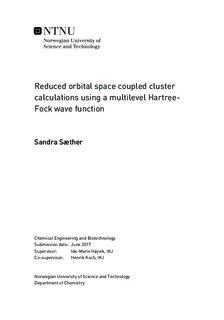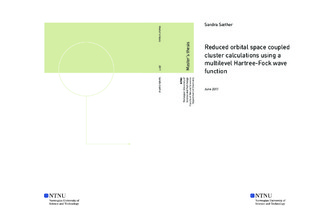| dc.description.abstract | Embedding, or multilevel, schemes have become exceedingly popular in recent years. The idea is to divide the system into an active part, which is treated by an accurate quantum mechanical method, and then treat the rest of the system, referred to as the inactive part, with a less accurate, more computationally efficient method. In this work, recent developments in multilevel Hartree-Fock theory (MLHF) is connected with coupled cluster singles and doubles (CCSD) to enable computation of accurate size-intensive properties for large molecular systems. The method needs no a priori orbital assignment, no bonds are broken and one wavefunction describes the whole system. One part of the wave function is described at CCSD level, one part at HF level and the other kept constant after an initial density start guess. The objective is to explore whether a full HF calculation is needed for a reduced space CC model, or if only a region around the CCSD space needs to be optimized. Specifically, will the reduced space CCSD results be compromised when embedded in a MLHF wave function rather than a HF wave function.
The MLHF method makes use of a molecular orbital (MO) density matrix driven optimization procedure to optimize only a subset of the MOs in the Slater determinant by using an orthogonal parametrization that ensures conserved symmetry, trace and idempotency properties for both the active and inactive density matrix. This is connected with CCSD by generating a set of canonical MOs from the active density, and using these MOs and the orbital energies as a starting point for the CCSD calculation. Since the reference wave function is not a HF wave function, this introduces some changes in the CCSD working equations. All changes enters through a modified Fock matrix.
Some benchmarking calculations on core excitations have been carried out on smaller systems to establish the effect of only having a partly optimized HF state as a reference state, and the method is showing promising results. The errors are small, but still large enough to compromise the CCSD calculation. However, as this is for small systems, these preliminary results are promising for the application on larger molecular systems. From the results, it is expected that local CC calculations on large systems can be carried out in a MLHF framework without compromising accuracy. | |

